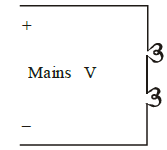Technical Test SSC JE: Electrical Engineering (EE)- 3 - Electrical Engineering (EE) MCQ
30 Questions MCQ Test Electrical Engineering SSC JE (Technical) - Technical Test SSC JE: Electrical Engineering (EE)- 3
A cube of material of side 1 cm has a resistance of 0.002W between its opposite faces. If the same volume of the material has a length of 8 cm and a uniform cross-section the resistanceof this length will be
The incandescent bulb rated respectively as P1 and P2 for operation at a specified main voltage are connected in series across the mains as shown in the figure. Then the total power supplied by the mains to the two bulbs.

| 1 Crore+ students have signed up on EduRev. Have you? Download the App |
A metal filament lamp X rated 40 W, 100 V is connected in series with another lamp Y of the same type rated 100W, 200V. A voltage of 200V is applied across the combination then
A 100W, 200V, filament lamp has operating temperature of 2000ºC. The filament materialhas resistance temperature coefficient of 0.005 at OºC per ºC. The current taken by the lamp at the instant of switching with 200V supply with filament temperature of 20ºC will be
The equivalent resistance at 'the points X1 and X2 in the circuits shown below
In the circuit shown in the given figure. The current through the inductor L is
A series RLC circuit is switched ON to a step voltage 'V' at t=0. What are initial and finalvalues of the current in the circuit respectively?
(1) Under steady state condition, a pure inductor act as a short circuit for direct current
(2) The potential drop across an inductance is proportional to the rate of change of current
According to maximum power transfer theorem, when is the maximum power absorbed by onenetwork from another network ?
At resonant frequency a R-L-C series circuit draws maximum current due to the reason that
If for sinusoids of same frequency but ofdifferent amplitudes and phase difference areadded the resultant is a
A pure capacitance connected across 50Hz, 230V supply consumes 0.04W. This consumption is attributed to
A 2-terminal network consist of one of the RLC elements. The element is connected to an ac supply. The current through the element is IA when an inductor is inserted in series between the source and element 2IA the current through the element becomes. What is this element ?
With the increase in applied frequency, thedielectric loss in a material will
A 100W, 100V bulb is to be supplied from 220V, 50Hz supply. Which of the following arrangement is preferable ?
A small capacitance is added to a highly inductive circuit
Capacitive susceptance is a measure of
Q-factor of a series R-L-C circuit possessing resonant frequency of 10Hz and bandwidth of 5Hz is
A parallel circuit is said to be in resonance when the admittance is purely
A conductor of length 100 cm moves at right angle to a uniform field flux density of 1.5 W6/m2 with a velocity of 50 m/s. The emf induced in the conductor will be
Magnetic materials which may be readily magnetized in either direction are
The relative permeability is less than unity in case of
A 1000 turn solenoid develops an average induced voltage of 120 volts. Over what timeinterval must a flux change of 60 milli-webers occurs to produce such a voltage ?
A long solenoid with 2000 turns is 0.8 m long. What is the magnetising force in the centre of this solenoid, if the exciting current is 2A
For a D.C. machine laboratory following type of DC supply will be used
Lamination of core are generally made of
The speed control of dc shunt motor in both directions can be obtained by
A synchronous motor operates at rated voltageand rated frequency and has a load torque angle of 30º. If both the terminal voltage & frequency are reduced by 10%, then
The nature of armature mmf for a zero power factor lagging load in a 3-f alternator is
|
23 videos|89 docs|42 tests
|
|
23 videos|89 docs|42 tests
|



















